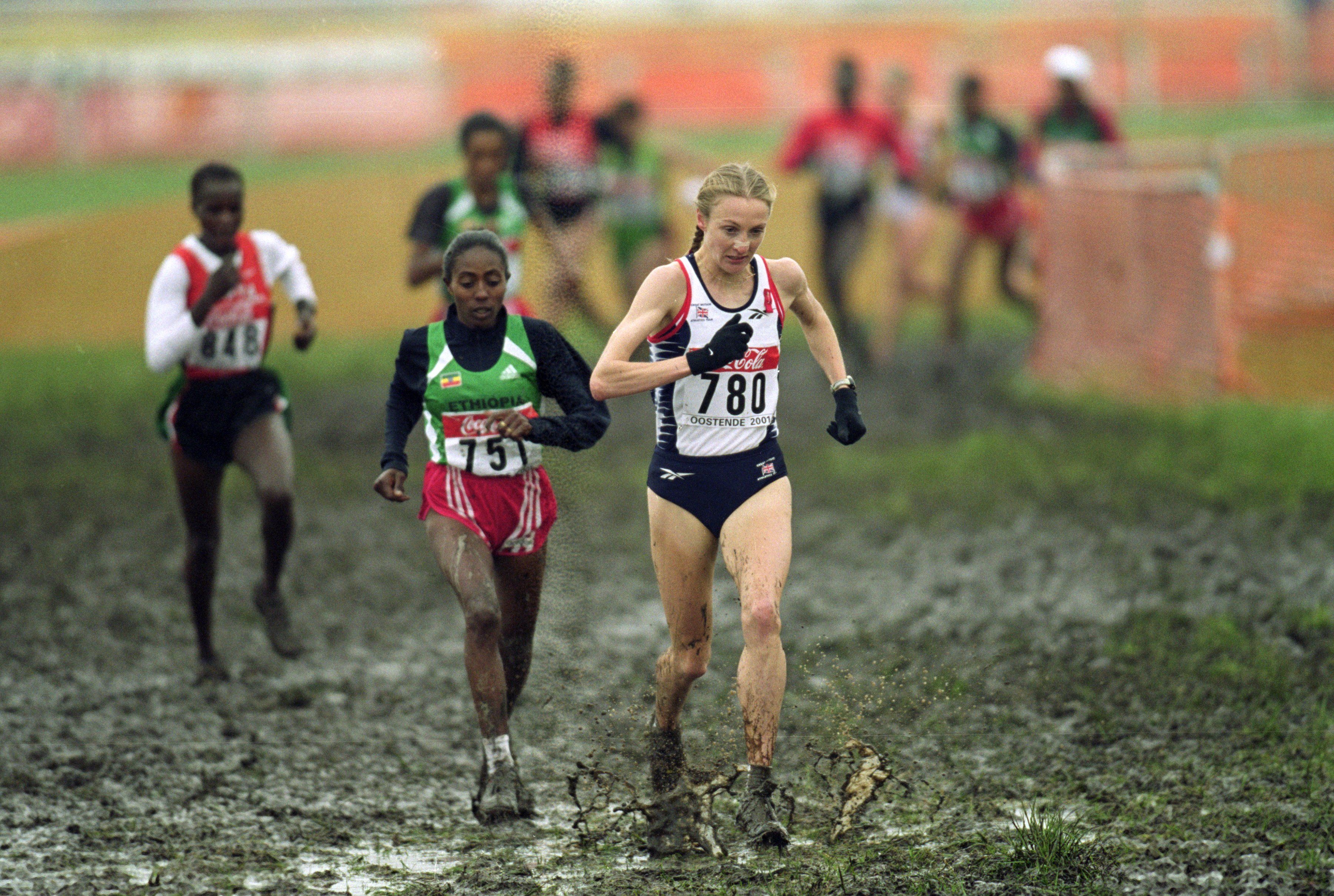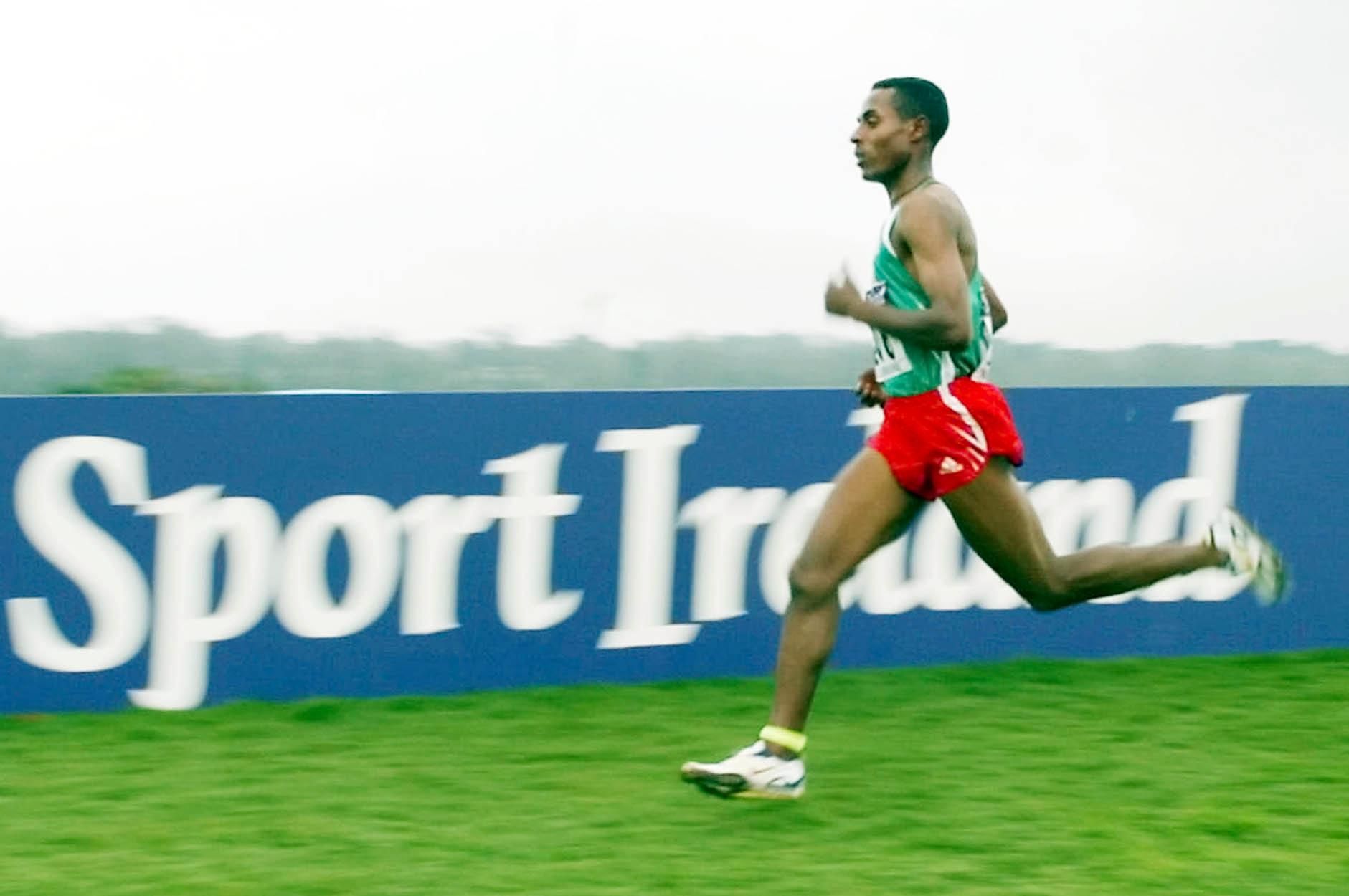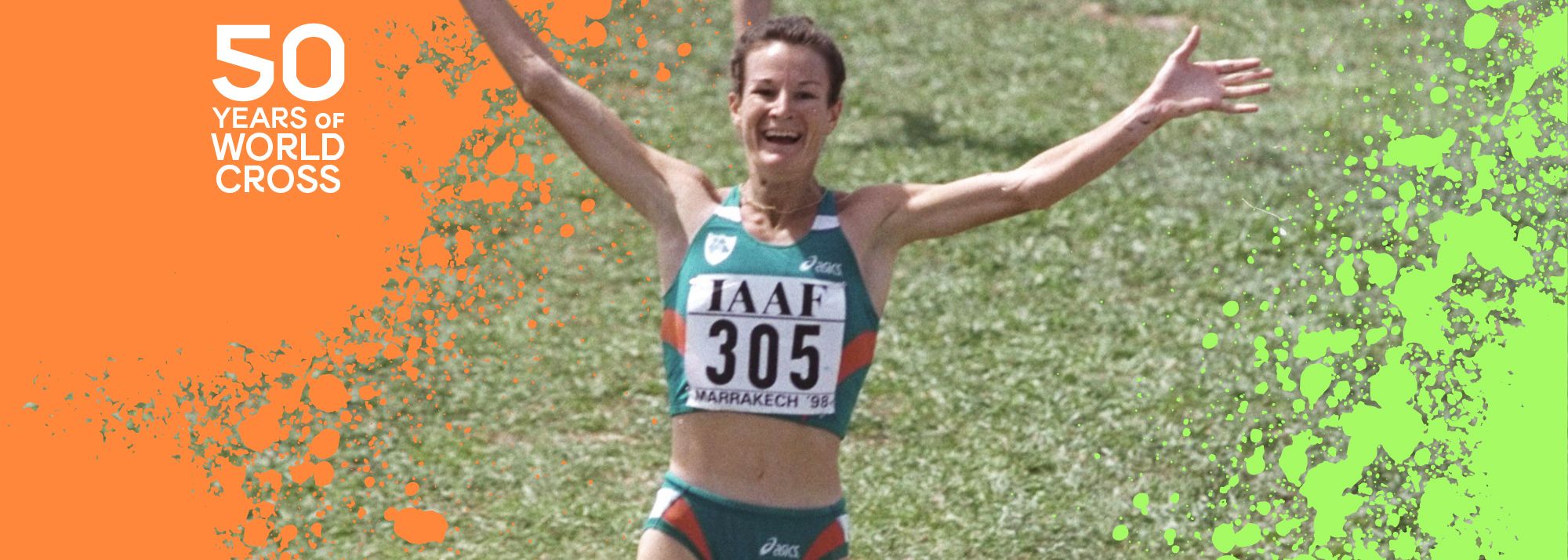Sonia O'Sullivan wins the women's long course race at the 1998 World Cross Country Championships (© Getty Images)
1973-1982 | 1983-1992 | 1993-2002 | 2003-2011
It was with a view to attracting more middle-distance runners to the World Athletics Cross Country Championships that the sport’s governing body decided to introduce short course races. From 1998 onwards, the championships expanded to become a two-day, six-race affair, with a 4km event for senior men and women on either day.
The allure of the truncated race started to revive Sonia O’Sullivan’s competitive instinct as she strove to rebuild her career, and her shattered confidence, on a four-month-long training trip to Australia.
After her failure to finish the Olympic 5000m final in Atlanta in 1996 and her exit in the 5000m heats at the 1997 World Athletics Championships in Athens, the 28-year-old Irish athlete felt that the novelty of the 4km race would be an ideal target on the road to rehabilitation.
But then the effects of training at altitude and upping her weekly mileage to 120 started to show significant benefits. After clocking 15:03.28 for 5000m in Melbourne, the 1995 world 5000m champion decided to concentrate on the extended 8km long-course race instead.
It was only after emerging victorious from that thrilling contest on the opening day of the landmark 1998 World Athletics Cross Country Championships in Marrakech that O’Sullivan decided to also contest the inaugural women’s short race on the Sunday.
Even then, it was against the wishes of her coach, and despite a freak injury, that the endearingly-grounded soul from Cobh – the southern Irish seaport that also produced the engagingly-pugnacious football figure Roy Keane – came to be the first athlete to achieve a world cross country long and short course double.

Sonia O'Sullivan in action during the 4km race at the 1998 World Cross Country Championships in Marrakech (© Allsport / Getty Images)
Such was O’Sullivan’s new-found strength and speed-endurance, she was comfortably able to keep up with Paula Radcliffe’s fierce pace in the long course race before burning off the determined Briton in the closing stages. She even managed to maintain her composure when the marshals forgot to guide the leaders into the finishing straight, squeezing through a gap in the fencing.
Crossing the line three seconds clear of Radcliffe, who had lost by two seconds to Ethiopia’s Olympic 10,000m champion Deratu Tulu in Turin 12 months previously, O’Sullivan became only the second Irish world cross country champion, following in the footsteps of Olympic marathon silver medallist John Treacy, winner of the senior men’s race in 1978 and 1979.
“Everyone told me to quit while I was ahead, but I wanted to see what I could do in the shorter race,” she subsequently confessed. “Even my coach, Alan Storey, told me to go out and have a pint of Guinness to celebrate.”
MOWA artefacts
The singlet that Paul Tergat wore for his 1998 victory, together with shoes worn by Sonia O’Sullivan and Paula Radcliffe for their respective 1998 and 2001 successes, are among the artefacts included in the Museum of World Athletics (MOWA).
Instead, on the Saturday evening, O’Sullivan went out shopping to one of the souks of Marrakech and badly gashed her shin while trying to evade a jewellery vendor who was desperately trying to sell her a bracelet. “I walked into a concrete bollard and there was blood everywhere,” she said.
Still, needled by the thought that a victory by a rival in the short course race would weaken her claim to be the world cross country champion, O’Sullivan jogged to the course for the 4km race on the Sunday.
En route, her mobile telephone rang. It was Storey, the distance guru who guided Britain’s Mike McLeod to Olympic 10,000m silver in Los Angeles in 1984. “He wasn’t happy,” O’Sullivan recounted, “but I told him to imagine I was a tennis player doing the doubles. He said: ‘Thank god, there’s no mixed doubles, then…’”
The mixed relay was to come to the World Cross Country Championships in Kampala in 2017 but in Marrakech in 1998 O’Sullivan proceeded to serve up a historic winning double. Taking on the world for the second time in 24 hours, she cruised home, 14 seconds clear of local hope Zahra Ouaziz.
It earned O’Sullivan a second $40,000 prize. Kudos, however, was her principal motivation.
“The second victory was 10 times sweeter than the first,” she reflected. “What if whoever won the short race today had not done the long race? There would have been a question mark.
“I was a bit greedy. I did not want to share the honour. Now that I have done it, others might try.”
Kenya’s John Kibowen, winner of the inaugural men’s short course race on the opening day, was content to settle for his single success. Of the few men who did attempt the double in Marrakech, the most successful was Zimbabwe’s Kudakwashe Shoko. He finished 32nd in the 4km race and 51st in the 12km event.

Athletes contest the men's 4km at the 1998 World Cross Country Championships, won by John Kibowen (© Getty Images)
The only athletes other than O’Sullivan to have achieved long and short course doubles are two of the Ethiopian all-time greats of the sport: Kenenisa Bekele, who accomplished the feat five times in succession from 2002, and Tirunesh Dibaba, who triumphed in 2005.
Radcliffe and Ethiopia’s Gete Wami both came close in the mud-bath of the Wellington Hippodrome in Ostend in 2001. On the Saturday, Radcliffe had her redemption day in the 7700m long race, hauling her way past her long-time track and country nemesis in the closing stages to triumph by three seconds.
It was very nearly double redemption. Radcliffe had victory in sight in the short course race the following day but Wami outsprinted the future marathon world record-holder in the final 50m, winning by a second.

Gete Wami and Paula Radcliffe battle at the 2001 World Cross Country Championships (© Getty Images)
The preceding race on the second day in Ostend was the U20 men’s 7700m event. It was won, by a record margin of 33 seconds, by a diminutive 18-year-old Ethiopian called Bekele.
The day before, the 5ft 5in teenager had finished just two seconds down on Kenya’s Enock Koech as runner up in the men’s short race. So Kenenisa Bekele was already a double medallist before he travelled to Dublin for the 2002 championships.
It was there, at Leopardstown Racecourse in the Irish capital, that Bekele showed his true pedigree as one of the great thoroughbreds of distance running.
On the Saturday, the 19-year-old with the smooth-striding style cantered to a comfortable victory, finishing seven seconds clear of Kenya’s Luke Kipkosgei.
The Ethiopian team management had said he would decide after the race whether to contest the longer event. Having amassed a convincing lead, however, Bekele made up his mind before reaching the finish. “I eased off to save myself for the long race,” he confessed afterwards.

Kenenisa Bekele on his way to a long and short course double at the 2002 World Cross Country Championships (© AFP / Getty Images)
Nobody could match him in the 12km race on the Sunday. Bekele won by six seconds from the Kenyan-based Tanzanian John Yuda. In doing so, he became the first man to complete the long and short course double and also – with his gold from Ostend the previous year – the first to secure titles in all three men’s races.
He was the first Ethiopian victor in the men’s long race since Bekele Debele in 1983, also succeeding his compatriot as the youngest ever winner of the title.
Much more was to follow from the young King Kenny as the World Athletics Cross Country Championships entered a fourth decade.
Third decade of World Cross action
1993 Amorebieta, Spain
William Sigei led a Kenyan sweep of the first five places in the men’s race, with Haile Gebrselassie of Ethiopia a notable seventh. Lynn Jennings of the US finished third in her bid for a hattrick of women’s titles, behind Portugal’s Maria Albertina Dias and Ireland’s Catherina McKiernan, runner-up for the second successive year.
1994 Budapest, Hungary
Kenya took seven of the eight titles, Portugal claiming the team prize in a women’s race won by Hellen Chepngeno ahead of serial ‘bridesmaid’ McKiernan. Sigei retained the men’s crown, outkicking his compatriot Simon Chemoiywo and, surprisingly, world 10,000m champion Gebrselassie.
1995 Durham, UK
McKiernan had to settle for a fourth successive silver after being caught and passed on the final hill by Deratu Tulu, the Ethiopian taking the senior women’s title despite having arrived at the course just an hour before the start after being stuck overnight in Athens airport without any sleep. Paul Tergat opened his five-year reign as senior men’s champion, the tall Kenyan finishing eight seconds clear of teammate Ismael Kirui, with Morocco’s Salah Hissou third and Gebrselassie fourth. Annemari Sandell won the U20 women’s race, the first Finnish triumph since Pekka Paivarinta’s senior men’s victory in 1973.
1996 Cape Town, South Africa
Tulu lost 250m when being barged to the ground at the end of the first lap, suffering a cut that required seven stitches. She fought back to finish fourth as her fellow Ethiopian Gete Wami took the senior women’s title. Tergat floated to victory in the senior men’s race, finishing 12 seconds clear of Hissou.
1997 Turin, Italy
Tergat completed a hattrick of titles in a titanic tussle with Hissou, edging the Moroccan by two seconds. Tulu swept past Briton Paula Radcliffe 30m out to regain the senior women’s crown, Ethiopia claiming team gold for the first time.
1998 Marrakech, Morocco
John Kibowen beat Kenyan teammate and favourite Daniel Komen to win the first ever 4km short course race. Victory in the women’s race the following day completed an historic long-short double for Ireland’s Sonia O’Sullivan, while Tergat made it four consecutive wins in the senior men’s long race.
1999 Belfast, UK
Tergat stretched his winning run to a fifth year in the men’s long course race, finishing four seconds clear of compatriot Patrick Ivuti, Kenya notching a 14th successive team success. Wami secured her second long course victory.
2000 Vilamoura, Portugal
After a sleepless night of arguing in the Kenyan camp about the inclusion of Charles Kamathai, Tergat could only finish third in the senior men’s long race, the Moroccan-born Belgian Mohammed Mourhit becoming the first European winner since Carlos Lopes in 1985. Tulu completed a hattrick of senior women’s long race wins, while Kenya’s John Kibowen regained the men’s short course crown and Ethiopia’s Kutre Dulecha pipped Morocco’s Zahra Ouaziz and Margaret Ngotho of Kenya in the women’s 4km, all three clocking the same time.
2001 Ostend, Belgium
Mourhit retained the men’s long course title on home mud, while Kenenisa Bekele won the U20 men’s race and finished a close second to Kenya’s Enoch Koech in the men’s short event. Radcliffe and Wami finished 1-2 in the women’s long race, then 2-1 in the 4km event.
2002 Dublin, Ireland
Radcliffe retained her long course crown ahead of US marathoner Deena Drossin. Kenya’s Edith Masai took the first of her three short race titles. Bekele secured the first men’s long-short double.
Simon Turnbull for World Athletics Heritage









